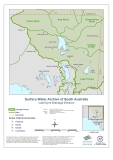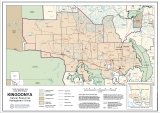Geography
Lake Gairdner ( 31"34'S, 136"00'E) is a large endorheic lake1 in central South Australia, and is considered the fourth largest salt lake2 in Australia when it is flooded.
The lake is over 160 km (100 miles) long and 48 km (30 miles) across with salt over 1.2 metres (4 feet) thick in some places. It is located west of Lake Torrens, 150 km northwest of Port Augusta and 440 km northwest of Adelaide. It is located in the Gawler Ranges.
There is very limited public access to this park which is surrounded by pastoral leases. The easiest public access is from the main road running from Yardea to Kingoonya, at The Brothers Well, a concrete catchment at the side of the road at the Southern end of Moonarie station (though the road signs would have you believe that you were on Yardea Station). The road is dirt, but quite good enough for two-wheel drive vehicles unless it is wet, when it is likely that it will be closed by the Highways Dept.
Ordinarily, the country is totally arid, and devoid of free water, surface or underground. In the summer it can be extremely hot: in the springtime, though, this country has great attraction for birdwatchers and botanists.
References
1. An endorheic basin (from Greek endo "inside" + rhein "to flow"; also terminal or closed basin) is a closed drainage basin that retains water and allows no outflow to other bodies of water such as rivers or oceans. Normally the water accruing in drainage basins flows out through surface rivers or by underground diffusion through permeable rock to the oceans. However, in an endorheic basin, rain (or other precipitation) that falls within it does not flow out but may only leave the drainage system by evaporation and seepage. Endorheic basins are also called internal drainage systems. Some of the largest lakes in the world are endorheic. Good examples are the Aral Sea and the Caspian Sea, the world's largest saline body of water cut off from the ocean.
2. A salt lake or saline lake is a landlocked body of water which has a concentration of salts (mostly sodium chloride) and other minerals significantly higher than most lakes (often defined as at least 3,000 milligrams of salt per liter). In many cases, salt lakes have a higher concentration of salt than sea water.
Images
Documents
Links
Reference Material
- Airports
- Biology
- Climate
- Geography
- Geological
- Government
- History
- Lunar
- Mining
- Native Title
- Salt Lakes of Australia
- Salt / Dry Lakes of the World
- Glossary


